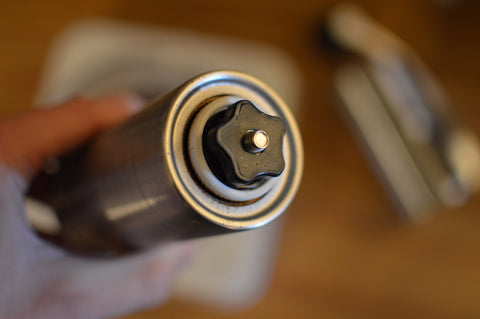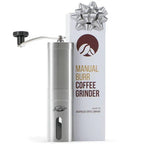I remember my first cup of french press coffee. It was the cup that opened my eyes to the wonderful flavors coffee can have, but it was also difficult to drink.
I hated the grittiness.
Sediment in french press coffee serves a purpose, but it tends to get on our nerves. If only there was a way to still get the benefits of it without having to choke it down…
In this blog, we’ll look at why you want some sediment, but also five different ways you can reduce the french press sediment in your final mug
Why You Want A Little Sediment In Your French Press Coffee
French press sediment is essentially tiny coffee ground particles. These particles don’t dissolve, which is why they feel grainy and gritty. They actually accomplish a few things that make french press coffee special:
- The coffee particles tone down the acidity. The coffee solids actually bond to some of the acids that are dissolved in the water. When you take a sip, your tongue feels the coffee particle more strongly than the acid, and your brain interprets the flavor to be less acidic overall.
Read: The Ultimate Guide To French Press Coffee
- The coffee particles create a full, satisfying body. That boldness that you love from french press coffee? That’s largely created by the presence of these super tiny grounds floating around in your brew. Your tongue interprets them as giving your coffee a satisfying, full mouthfeel.
The sediment isn’t all bad. But I agree, it’s not very fun to drink (though I do know some people who think otherwise).
Let’s look into some ways you can reduce your french press coffee’s sediment while still enjoying the benefits it provides.
1. Follow Grinding Best Practices
Probably the biggest cause of too much sediment is poor grind uniformity. When you grind lazily or with cheap tools like a blade grinder you end up with grounds of many sizes. The smallest of these grounds—”fines”—slide right through the filter.
Read: 5 Tips For Getting The Most Out Of Your Manual Coffee Grinder
By following some best practices (and using a burr grinder), you can cut down on these unnecessary fines for a bit of a smoother cup.
- Hold the grinder as still as possible while grinding
- Hold the grinder vertically while grinding
- Clean the burrs every couple months
- Replace the burrs when they become dull
When you swing your device around while grinding or hold it at an angle, the beans don’t funnel in smoothly, which creates inconsistency in the grounds. Similarly, if your burrs are coated in leftover coffee oils or just dull from a year of use, they won’t perform nearly as well as they should.

I suggest starting here. Care for your grinder, and it’ll care for you.
2. Try Skimming The Surface End-Brew
Here’s a way to take out a lot of the sediment at the end of the brewing process without compromising the actual brewing.
Read: How To Taste Coffee Mouthfeel
When there’s only 15-25 seconds or so left of the brew, grab two spoons, hold the scoop ends next to each other, and slowly skim the surface of the brewing coffee.
By skimming the surface, you take away many of the micro-grounds that are suspended at the surface in the foamy area. Now, when you press down the filter, those surface-level fines won’t immediately go through the filter because of the pressure you’re creating.
Note: be very careful about your spoons. Metal spoons can crack or chip glass french presses.
3. Use A Coarser Grind Setting
It’s certainly possible that you’re actually grinding a little more fine than is necessary with a french press. Try a coarser setting and see if that helps reduce the sediment some. However, I’d be willing to bet that it’s more likely that you just need to revisit the grinding best practices instead.
Keep in mind that if you coarsen the grind setting, you’ll probably need to increase the brewing time slightly to produce the same level of extraction. Adjust how your taste buds tell you to, but I’d imagine that 10-15 seconds longer should be enough for 1-2 settings coarser.
4. Pour Through A Second Fine Strainer
If the steps above just aren’t working out like you want them to, here’s an idea: use a second strainer. Fine mesh strainers can be found at your local kitchen supply store or online, like this one.
When you pour your french press coffee into your mug, slow down the pour intensity and pour through this strainer. The mesh will catch a good portion of the micro-grounds, but it’ll also take a second to drain the coffee, so don’t pour very aggressively.
The nice thing about this strategy is you get a fine mesh strainer out of it that can be used for cooking, tea brewing, or a whole bunch of other things.
5. Let The Sediment Settle
Micro-grounds, even though they do float, are ultimately more dense than the brewed coffee. This means that, given enough time, they will settle at the bottom of your mug or press. However, if you agitate the grounds by stirring or moving quickly, they’ll float up again.
Read: 5 Things Every French Press Coffee Lover Should Know
Here are the two ways you can use this physics fact to your advantage:
- Move slowly with your french press. Don’t stir like crazy or dance around your kitchen while holding your french press. When it’s time to plunge the filter down, do so slowly. This will keep most of the sediment at the bottom of the press where it should be.
- Chill with your coffee mug. Don’t swirl your coffee in the mug. If you pour in any milk or cream, give the grounds a minute or two to settle at the bottom again. When you get down to the bottom, don’t feel like you have to drink the very last sip (where all the grounds are).

This step is particularly easy and something I suggest whether you have a lot of grit or hardly any at all.
---
There you go! Surely one or two of these tips will reduce your french press coffee’s sediment dramatically. Try out a few different ones and see what you like and which ones don’t really fit with your style or routine.
And, of course, don’t forget that your french press coffee can only be as delicious as the beans you use with it.


